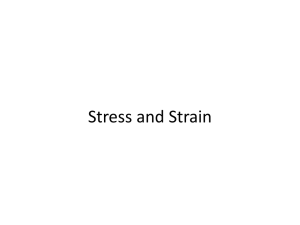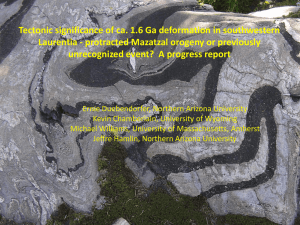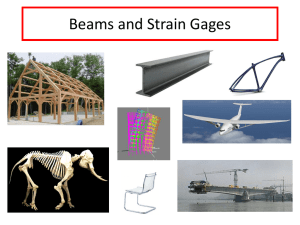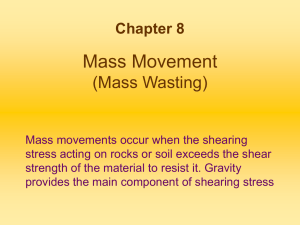PowerPoint
advertisement
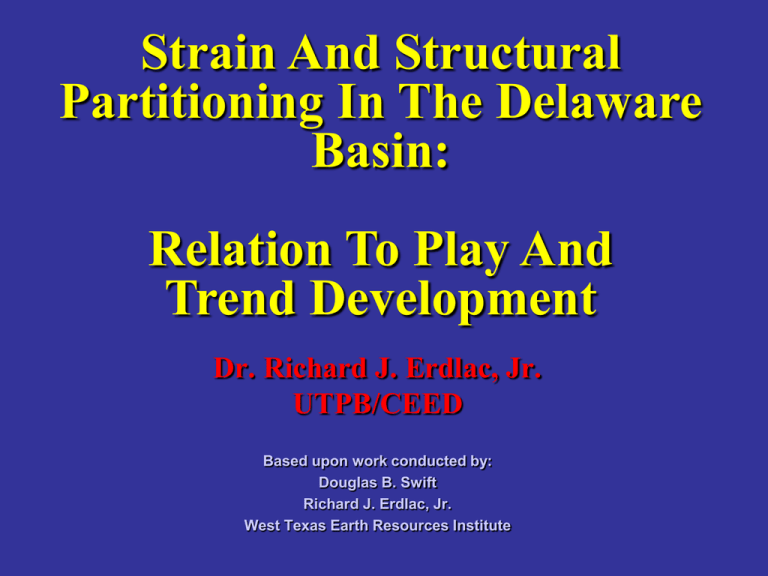
Strain And Structural Partitioning In The Delaware Basin: Relation To Play And Trend Development Dr. Richard J. Erdlac, Jr. UTPB/CEED Based upon work conducted by: Douglas B. Swift Richard J. Erdlac, Jr. West Texas Earth Resources Institute Exploration Premise Determination of the play or trend type in a given region requires knowledge of: Structural Deformation Styles/Mechanisms You don’t say that all faults are normal when compressional tectonics were active. Sedimentation Styles/Mechanisms You don’t look for salt deformation structures where salt was never deposited. DEFORMATION What is meant by the term? 1. Structural changes that take place in the original location, orientation, shape, and volume. 2. Physical or chemical processes that produce the structural change. 3. Geologic structures that form to accommodate the changes. 1) DEFORMATION: change in original rock body. location = translation = rigid body motion (flexural slip folding, plate tectonics) orientation = rotation = rigid body motion (monocline, listric normal faulting) (ORIGINAL ROCK SIZE PRESERVED) shape = distortion = non-rigid body motion (deformed fossil) volume = dilation = non-rigid body motion (fractures expand rock, stylolites shrink) (ORIGINAL ROCK SIZE NOT PRESERVED) (strain occurs) Structural changes can vary according to scale of observations or the definition of the structural boundaries. 2) DEFORMATION : physical & chemical processes that produce structural changes (within minerals). 1) Microfracturing; Cataclasis; Frictional Sliding (breaking of crystal lattice) 2) Mechanical Twinning; Kinking (bending of crystal lattice) 3) Diffusion Creep (T activated) (movement of crystal vacancies and atoms) 4) Dissolution Creep (pressure solution = stylitization) (dissolution and reprecipitation of material) 5) Dislocation Creep (intercrystalline slip of lattice structure along a plane) This is usually what is meant by strain partitioning. 3) DEFORMATION : geologic structures that form to accommodate the changes. Joints and Shear Fractures Faults Folds Cleavage, Foliation, and Lineation Shear Zones This is what is generally considered within the exploration and production mode. However all three definitions are truly applicable. What is strain partitioning? The manner of separating different mechanisms of deformation that lead to overall bulk or average strain in a rock. (Ramsay & Huber, 1983) (This definition tends to focus on physical and chemical changes.) Strain can also be related to the change in any linear dimension of a body. Strain: e l f lo lo (e is also called extension.) Plane Strain The easiest way to consider deformation is to assume little to no volume change in a broad sense and that one strain axis is unchanged. (One axis of deformation remains unchanged.) Pure Shear = Coaxial Strain Plane Strain The easiest way to consider deformation is to assume little to no volume change in a broad sense and that one strain axis is unchanged. (One axis of deformation remains unchanged.) Pure Shear = Coaxial Strain Plane Strain The easiest way to consider deformation is to assume little to no volume change in a broad sense and that one strain axis is unchanged. (One axis of deformation remains unchanged.) Simple Shear = Noncoaxial Strain ( = tan) =0 = 0.40 = 0.60 = 1.00 Plane Strain The easiest way to consider deformation is to assume little to no volume change in a broad sense and that one strain axis is unchanged. (One axis of deformation remains unchanged.) Simple Shear = Noncoaxial Strain ( = tan) =0 = 0.40 = 0.60 = 1.00 STRUCTURAL PARTITIONING Using the definitions for deformation we can partition structures in a megascopic manner according to the geometric styles that predominate in a given area. Let us look at examples within the Delaware-Val Verde Basin region. Delaware – Val Verde Basins Seismic Data Delaware – Val Verde Basins Play Map of DVVB (15) Tectonic Map of DVVB STRUCTURAL PARTITIONING Three Examples Brown-Bassett Field: pure shear (Brown-Bassett Play) Waha to Coyanosa: pure shear (Central Basin Platform Border Region) Grisham Fault Zone: (Grisham Uplifted Region) simple shear Brown-Bassett Field Brown-Bassett Play Folding/Faulting (?) Brown-Bassett > 1.4 B mcf Play Map of DVVB Seismic Map Production Map JM > 705 MM mcf Will-O > 50 MM mcf Tectonic Map of DVVB Folding/ Faulting (?) Brown-Bassett Folding/ Faulting (?) Brown-Bassett Dry Fork Ridge Anticline, Wyoming Folding/ Faulting (?) Brown-Bassett Dry Fork Ridge Anticline, Wyoming Folding/Faulting (?) Brown-Bassett Note footwall reversal. Is it real? STRUCTURAL PARTITIONING Three Examples Brown-Bassett Field: (Brown-Bassett Play) pure shear Waha to Coyanosa: pure shear (Central Basin Platform Border Region) Grisham Fault Zone: (Grisham Uplifted Region) simple shear Waha To Coyanosa Waha/Worsham-Bayer-Coyanosa Area Folding/Faulting Play Map of DVVB Seismic Map Worsham-Bayer > 455 MM mcf Waha > 319 MM mcf E > 241 MM mcf M Waha, W > 285 MM mcf Production Map Coyanosa > 491 MM mcf E > 989 MM mcf D > 1 B mcf W Tectonic Map of DVVB Seismic Map S W,W Folding / Faulting W S W,W W Tectonic Map of DVVB Waha, W Waha DB Group Shoot 114 Synclinal Area Seismic Map C C S CBP Folding / Faulting S CBP Tectonic Map of DVVB Coyanosa Synclinal Axis DB Group Shoot 104 CBP Margin Seismic Map S CBP S Folding / Faulting A CBP A Tectonic Map of DVVB CBP Coyanosa AnticlinalAnticline Axis Axis Projection Synclinal Axis DB Group Shoot 105 DB Group Shoot 114 DB Group Shoot 105 Folding / Faulting DB Group Shoot 104 Fault-induced folds at outcrop scale, Devonian strata, the Appalachian Mountains (McConnell et al., 1997). STRUCTURAL PARTITIONING Three Examples Brown-Bassett Field: (Brown-Bassett Play) pure shear Waha to Coyanosa: pure shear (Central Basin Platform Border Region) Grisham Fault Zone: simple shear (Grisham Uplifted Region) Grisham Fault Zone Grisham Fault Zone / Grisham Uplifted Region Simple Shear Riedel Shear Modeling Tchalenko, 1970 Simple Shear B A 10 CM 0 10 CM 0 2o Convergent Left-Lateral System 2o Convergent Left-Lateral System Wilcox et al., 1973 & P.G. Temple (unpublished work) Faulting/Folding/Shear Zones Production Map Greasewood > 354 MM mcf Athens > 24 MM mcf Play Map of DVVB Tectonic Map of DVVB Mi Vida > 1 B mcf Toyah > 7 MM mcf Faulting/Folding/Shear Zones A S F A F GF S D Seismic Map GF Tectonic Map of DVVB DB Group Shoot 108 Grisham Fault Zone Anticlines Fault Syncline Syncline Dunnavant D Faulting/Folding/Shear Zones Seismic Map A A GF GF Seismic Map Tectonic Map of DVVB DB Group Shoot 117 Grisham Fault Zone Anticline Axis Faulting/Folding/Shear Zones A A A S S Seismic Map Tectonic Map of DVVB DB Group Shoot 119B Anticlines Syncline IS THE GRISHAM FAULT ZONE UNIQUE? NB – North Baylor VH – Van Horn L – Lobo CM – Chispa Mountain ML – Mount Locke V – Valentine C – Candelaria R – Ruidosa S – Shafter (Chalk Draw Fault) P – Presidio (Tascotal Mesa Fault) T _ Terlingua (Monocline) SE – Santa Elena Trans-Pecos E-W Structural Zones (Dickerson, 1980 – Trans-Pecos Region – NMGS) Faulting/Folding/Shear Zones Other Possible Shear Zones Toro, S Perry Bass Grey Ranch S U M M A R Y 1) Deformation is documented in a variety of different ways, from microscopic to megascopic in scale. physical & chemical processes – will alter porosity & permeability. rigid body motion – generate permeability (fractures) & structural traps. 2) In its simplest manner strain can be considered to be either pure shear or simple shear (plane strain). 3) Deformed basins can be structurally partitioned into various strain categories (pure & simple) based upon the structural geometries or types encountered. 4) Knowing the partition type will define the play trend and the approach to exploration and production in that area.
